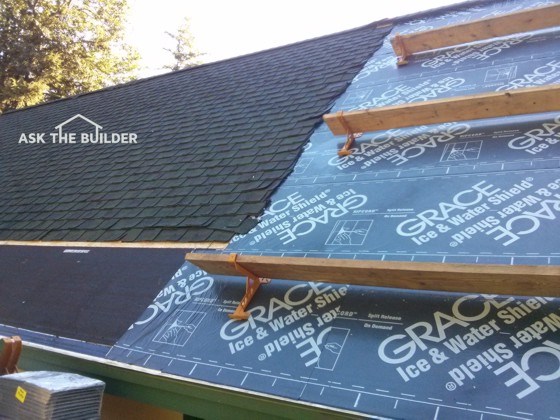DIY Install Roof Shingles

This is a simple but steep roof. The lack of chimneys, dormers, valleys and other things requiring flashings make this a doable project for a DIYr. Photo Credit: Tim Carter
DEAR TIM: Money is pretty tight and I need a new roof. I've watched a few videos on YouTube and believe I can handle the job. My old shingles need to come off and I'm working alone. How do I ensure no water will leak into my home since I can't get all the shingles off the roof in one day? There has to be a way I can keep my house dry. What are the other major obstacles I'll be facing? I have a simple ranch home with only one plumbing vent pipe sticking through the roof. Cleora O., Oakdale, CT
DEAR CLEORA: You're not alone in your quest to stretch budget dollars. Each week I receive more and more emails from people suffering with the lackluster economy we are all experiencing. I'm all in favor of you doing this job as long as you can do it safely and you have a great understanding of exactly how to do the job.
I've got hundreds of my own videos up on YouTube, but not a week goes by that I don't see questionable information in videos on YouTube. You can't trust all the information you see there. Be aware that anyone who can fog a mirror and can nail a shingle can upload a video to YouTube. No one but you is vetting the accuracy of the information.
Always cross check and verify what you see in a video with the written instructions provided by the shingle manufacturer. Some shingle manufacturers also have instructional videos showing how to install their products. Watch them if you can locate them.
To keep the inside of your home dry while you tackle this project, you need to strip off the old shingles and then recover that portion of the roof with a waterproof membrane, traditional felt paper or one of the newer felt-paper alternative underlayments before it might rain.
I've found it's best to work from the lower edge of the roof up to the top of the ridge when working solo. You may decide to only work a section of the roof about 12 feet wide.
If you put up finished waterproof membrane or some other underlayment on a lower portion of the roof and then still have to strip shingles above it the next day, the old shingles and nails can damage the products you've installed as they slide down the roof.
If you decide to work in sections like this, you should slide the new waterproof membrane or other underlayment under the existing shingles to prevent leaks if rain is in the forecast. You just need to slide it under the shingles about 4 inches.
Avoid the temptation or advice of neighbors to use a giant tarp to keep your house dry as you work. If it gets windy and you haven't secured it properly, it will become a giant sail. If the wind can get under a small part of the tarp and gain a purchase, the wind can peel the tarp off your roof much like you peel a ripe tangerine.
I think one of the biggest obstacles you'll face is how much physical labor you can endure. Roofing work is hard. Carrying shingles up a ladder is not easy. You have to figure out how you're going to install the first rows of shingles down at the bottom edge of the roof.
If the roof slope is shallow, you can do this backwards facing towards the ground, but it's not as easy as you might think. Working from scaffolding is safer, but you'd need to rent it and all the needed platforms so you can stand up in the air at the bottom edge of your roof.
Stripping off the old shingles may not be as easy as you think. Be sure you purchase a special roofing spade that's designed to remove asphalt shingles. It has serrated teeth on it's lower edge to help remove roofing nails. It also has a v-shaped piece of metal welded to the back of the spade to increase the leverage as you pop shingles from the roof. This tool will minimize frustration and save you hours of labor.
Be sure you purchase the best plumbing vent flashing. Flashings need to last as long or longer than the roofing material. The common plumbing vent flashings most use can fail in as little as ten years. I prefer to use the flashings from LifetimeTool.com.
I taped a video you can watch showing exactly how to install one of these plumbing vent flashings. This video explains the relationship between flashings and shingles and shows you step-by-step how to lace the shingles into and around the flashing.
Go here to watch the video:
http://go.askthebuilder.com/flashingvideo
I know what I said about videos on YouTube, but you can trust mine! I've installed lots of flashings over the decades and none have leaked!
Column 1103